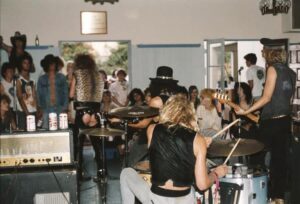Do you want to know which are the ten best NAS servers in 2022? Do you need a NAS device as a multimedia center via DLNA, server, or store your data or those of your company or business? Are you looking for a multimedia hard drive? Not sure whether to buy a Synology or Qnap server as a home NAS to use PLEX or KODI?
We will tell you which are the best NAS by the best price for your home or office. And we are going to introduce you to a brand that maybe you did not know, such as TerraMaster.
NAS (Network Attached Storage) servers are becoming more popular as home and small business storage. They are somewhere in the middle between local and cloud storage.
Brands such as Synology, Qnap, Western Digital, Netgear provide us with excellent options to manage our files online, set up our streaming server, or give a group of users access to a local network.
Everything is still under your control, and they also provide you with an easy way to backup and share your content. You will even be able to use them as music servers (compatible with iTunes), stream to all your devices, or as a central point of your company information.
We will share the ten best NAS servers that you can use for both home and office by different brands such as Synology, Qnap, Western Digital, Netgear, and many more.
What is a NAS server?
As its name suggests, a disk or NAS server is high-capacity storage that connects to your home or office network so that you can access your files from mobile devices and computers without connecting directly to the unit. You access through the network.
You can share files with your workers, consult documents online outside your home, use it as a multimedia server, as a backup disk for your photos, etc.
Components of a NAS
Like PCs, a NAS server has a CPU, RAM, and an operating system (usually a Linux-based OS). A model with 2GB of RAM and a Dual-Core processor is more than enough for a family, but you should look for a NAS with 4GB up to 16GB of RAM and a quad-core CPU if you are going to use the NAS in an office, or if you are going to need to install many virtual machines on your home NAS.
Suppose you will use the device to manage multimedia files with 1080p HD or 4K video resolutions. In that case, it is better to use a device with sound capabilities, especially if you need real-time transcoding.
This is especially important if you use it as a home media center with programs such as PLEX or KODI or share your iTunes library.
You will also need a powerful NAS if you like to install a lot of virtual machines on it. Look at the specifications of each model and what it is recommended for.
Do you need a DLNA server?
Digital Living Network Alliance (DLNA) is a standard designed to allow computers, NAS, printers, consoles, tablets, smartphones, and other devices with network access to communicate and share multimedia media such as photos, videos, and music over a wireless network.
And the good thing about it is that you don’t need a lot of knowledge to get it started. Typically in NAS servers, there is an option to activate it immediately (if it is not already activated previously).
Each DLNA device can identify other DLNA devices on the same network and automatically retrieve shared photos, videos, or music. A real advantage is to avoid getting involved with complicated settings.
Do you need a NAS server to install PLEX or KODI?
PLEX or KODI are two of the most used multimedia solutions for your home. With both programs, you will be able to set up a streaming center for your movies, TV series, or music in a simple way.
PLEX can be installed on both QNAP and Synology easily through their app stores. KODI is only on QNAP via the unofficial app store.
- You will need a high-capacity, high-performance QNAP NAS to set up Plex Media Server or KODI.
- The NAS never shuts down, making it perfect for these types of uses: streaming multimedia and accessing your digital media anytime, anywhere.
- The NAS must provide good file transcoding to ensure smooth and uninterrupted playback. The CPU should support hardware transcoding (of both Full HD content and 4K content).
Which QNAP NAS is recommended to use with PLEX or KODI? TS-x53D series and TVS-x72N series.
Which Synology NAS is recommended to use with PLEX? DS1019 +, DS918 +, DS3617xs.
Both QNAP and Synology offer a quick and easy installation of PLEX in their application centers:
In the case of KODI, you will have to install it on a QNAP NAS (there is no option in Synology): you must do them through the unofficial qnapclub application store by installing the repository on your NAS (https://qnapclub.eu/ in / repo.xml):
Other features to look for when buying a NAS
- Backup: they are perfect for making a backup copy of your computer, files, photos etc. Look for support for Time Machine (Mac), Rsync, FTP, backup copies in the cloud.
- Gigabit ethernet : all your devices must support it for the issue to work. Required for 4K streaming.
- Card reader: If you are a photographer it is a good addition.
- Dual Ethernet ports: perfect for receiving and sending data at full speed.
- Number of bays: It is so important that we have dedicated the following section to it.
- Plex Media Server : if you want to see all kinds of content on your NAS, make sure you have support for this app. Perfect if you have a device that doesn’t support DLNA.
- USB and HDMI ports: they will make your life easier, especially HDMI (you can directly connect your NAS to a TV or monitor).
- Video transcoding: you are going to need a good CPU with 4 cores.
Number of bays in your NAS, storage capacity and NAS drives: you have to choose a good hard drive for your NAS
Before buying a good NAS, you have to seriously consider its storage capacity and what type of hard drives we will use in them. Usually, these devices are sold without hard drives, and you have to buy the most suitable ones.
The simplest NAS servers only have a hole for a hard drive, but as we go up the level, we will incorporate more and more hard drives. From 1TB / 2TB (the simplest), through 6TB / 8TB (to store large multimedia files) up to 10TB / 20TB (perfect for offices).
There are models in which you will put HDD and SSD hard drives, combining the best of both worlds.
You only have to bear in mind one thing: with only two bays, you will not take advantage of everything that RAID offers you (we use multiple disk units where data is distributed or replicated in different ways).
If you want to get a good idea of the best RAID for your NAS, Synology has an excellent calculator.
Raid 1
It is the most typical Raid for a two-bay NAS. You will lose half the disk’s total capacity, but we achieve a high level of data protection. An identical copy of data is stored on the two hard drives.
Raid 6 vs Raid 10
Two of the most recommended types of RAID in a NAS are RAID 6 and RAID 10; you need a NAS with four hard drives or more.
- RAID 6: Offers high protection against disk failures and high read performance. The best to keep your data safe against disk failures.
- RAID 10: Excellent read and write speeds and high failure protection, but half the disk capacity is lost. The best to improve the performance of your NAS. It is a RAID 1 + a RAID 0.
Moral? Without wanting to take advantage of a NAS’s power, you will have to get a model with four or more bays.
Recommended hard drives for a NAS server
A 4TB disk can cost you around 120 dollars, so if you buy a Synology NAS server with two bays, which usually cost around 200 dollars, the total cost of the NAS server will be 440 dollars(2 hard drives + the NAS).
Internal hard drive brands often have special drives for use in NAS systems. Do not hesitate; it is the best option.
What are models of hard drives recommended to work with a NAS? We give you a few options:
- Seagate IronWolf, 4 TB, NAS, 3.5 ″ SATA 6 Gb / s 5900 rpm Internal HDD, 64 MB cache for RAID network attached storage It is one of the most recommended for a quality price. It is perfect for use in RAID. Job? It is somewhat more expensive. You have from 1TB to 18TB.
- WD Red 2TB Internal Hard Drive NAS 3.5 ″ – 5400 RPM, SATA 6 Gb / s, SMR, 256MB Cache. A highly recommended option for its good performance and high capacities. The transfer speed sometimes slows down a bit. You have 2TB, 3TB, 4TB and 6TB.
Qnap vs Synology
It is possibly the question you are asking yourself before buying your new NAS. They are the two most popular brands for home NAS.
Both Synology and Qnap are two Taiwan companies that have been with us since the 2000s.
Synology uses the DSM system and Qnap the QTS system on its NAS, both based on Linux.
With neither of the two, you are going to go wrong when buying your NAS, but you have to take into account the following differences between the two:
- QNAP NAS usually have better hardware if we compare prices of both companies (better processor and more RAM)
- Synology’s DSM operating system has a better interface and is easier to use, but Qnap and its QTS offer more customization options (it is more powerful), and the option to create virtual machines to install other operating systems.
- QNAP models usually have an HDMI port to connect directly to a TV or monitor.
- KODI can only be installed on QNAP NAS servers. In Synology NO.
- PLEX can be installed on both QNAP NAS and Synology NAS.
Top 10 Best Home & Business NAS Servers in 2022
1. QNAP TS-251B NAS (Qnap TS-251D) or Synology Diskstation DS218+ (Synology DS220+)
Depending on the price (older models are cheaper) and your needs, you may be interested in last year’s models (QNAP TS-251B and Synology DS218 +) or this year’s (Qnap TS-251D and Synology DS220 +). The exterior design is the same. It’s up to you.
1.1 QNAP TS-251B NAS
An excellent NAS with excellent performance and many connections, including an HDMI and several USB. The performance is very similar to the Synology DS218 +.
The disks are easily removed, and the operating system is very polished. The QTS operating system allows you to easily install various applications, such as Plex Media Server or running Ubuntu Linux. It comes without hard drives.
It comes with a 14nm 2.0GHz dual-core Intel Celeron J3355 processor with 2GB / 4GB of DDR3L
RAM (up to 8GB, comes with 4GB), a single Gigabit LAN port, and support for SATA hard drives up to 6Gb / s. It is equipped with AES-NI hardware-accelerated encryption.
1.2. Qnap TS-251D
Qnap has just unveiled the new model, the Qnap TS-251D, at CES 2020: a 2-bay NAS with a 2.0 GHz dual-core Intel Celeron processor with 2GB or 4GB of RAM available.
Supports 4K HDMI output and PCIe expansion for SSD caching and 10GbE / 5GbE / 2.5GbE connectivity.
Here is a comparative table with the main differences so you can choose better:
Performance is 15% higher on the new model, and transcoding and virtualization have improved. The HDMI 2.0 port allows using UHD 4K (in the previous one, it was limited to 30Hz). PCIe is faster in the new model. RAM has also been upgraded from DDR3L to DDR4. The new model TS-251D has lost the audio and microphone inputs.
1.3 Synology Diskstation DS218+
Another perfect option competes directly with the QNAP model. With either of the two, you will not go wrong.
Synology’s operating system is the best you’ll find: it offers you the ability to install many apps, easily make backups, host your website, or create a server in several easy steps. Almost everything you can do with Linux, you can do with this NAS.
It allows Ultra HD 4K video transcoding and has AES-NI hardware encryption.
It has Intel Celeron J3355 Dual Core 2 GHz CPU that offers up to 2.5 GHz, 2 GB DDR3L (expandable up to 6 GB), USB 3.0 ports, 1 GbE RJ-45 port.
1.4. Synology DS220+
Synology has introduced the new Synology DS220 +, a reasonable advance over the previous model: Intel Celeron J4025 2-core 2.0 GHz processor, 2 1GbE LAN ports, 6GB of maximum RAM, 2 USB 3.0 ports.
Perfect for 4K transcoding. It only lacks slots for M.2 SSD cache and 2.5 or 10 Gb ports for the LAN. Otherwise, excellent as the previous model.
Comparison table between both models? Synology DS220 + vs. Synology DS218 +: The DS218 + has an excellent value for money, but the DS220 + is a worthy successor.
Synology DS220 + vs DS120j vs DS220j
The following table may be helpful if you want to choose between the different Synology models that we will recommend below in this post:
2. Western Digital My Cloud Home – NAS Network Storage
One of the easiest NAS to configure: directly from your Android or iOS smartphone through an app (WD Discovery). In this configuration, you only have one hard drive from 2TB to 8TB, but you have a model with two bays that has two drives that go up to 20TB storage ( My Cloud Home Duo ).
You can make an automatic backup of the photos and videos on your phone, and through the USB 3.0 port, you can import photos, videos, and documents from USB flash drives and external hard drives.
It also has apps like PLEX, Dropbox, Google Drive to expand its streaming functions. It does not have FTP, SMB, and other protocols that we expect to see in a NAS (the approach is different in this model: simplicity prevails). Their software is not as comprehensive as on the Synology or QNAP models.
3. TerraMaster F2-221
Only one thing can be said: it will surprise you, both by design and performance. It is made of aluminum, and the discs can be easily removed and inserted. It supports AES hardware encryption and HD 4K video transcoding.
4. QNAP TS-453B or QNAP TS-453Be
The perfect NAS for PLEX, virtual machines, and for 4K (supports 4K H.264 dual-channel hardware decoding and real-time transcoding)
This model has an Intel Celeron J3455 processor, Quad-Core 1.5 GHz, Intel HD Graphics 500 graphics card, 4 GB DDR3L RAM (expandable), internal capacity for four bays (you will be able to take advantage of everything that it offers a RAID configuration) and data transfer speeds of up to 225MB / s upload and download.
And best of all, it can be expanded with a QM2 QM2-2S-220A expansion card (or similar) to, for example, be able to add SSD disks for the data cache.
The QNAP TS-453Be is similar to this one but without the front-end add-ons like the LCD screen, the USB-C port, or the SD card port: that’s why it’s cheaper.
5. Western Digital EX4100
A multipurpose NAS for all types of users. If you are looking for a NAS device to handle your backups, the EX4100 might be worth it. One of the most exciting features of this device is that it offers users backup options to cloud services such as Dropbox and Box.
The EX4100 comes with four bays that can accommodate different hard drives when it comes to storage options. It has a 1.6 GHz dual-core Marvell processor and 2 GB of RAM. Its setup is straightforward.
6. Synology DS218J Diskstation (2 bays) or DS220J
Synology DS218J
The best choice for an affordable home NAS. It has better hardware than models from previous years, although the design is the same. It seems that Synology doesn’t like to change the look of its NAS.
Something bad? To mount and remove the hard drives, we will have to open the lid of the device. In some QNAP options, we can insert the disk more efficiently. It has the full power of Synology applications.
It has two bays with a Marvell Armada 385 88F6820 CPU (1.3GHz Dual-Core), 512 MB DDR3 RAM, and the compatible drives are 3.5 ″ SATA HDD and 2.5 ″ SATA HDD (with adapter). You can fit up to 28TB. It has two USB 3.0 ports and an RJ45.
- You can also go for the Synology DS218PLAY if you want direct 4K video transcoding. And it only costs a little more.
Synology DS220J
A cheap two-bay NAS server with up to 32TB capacity (2.5 ″ or 3.5 ″ disks) perfect for home use or small businesses thanks to being able to implement RAID, RAID 1, JBOD, Basic, and SHR. Its performance is good, it has the Synology operating system, and it has many apps available.
It is a good upgrade compared to the DS218j as it has a 1.4GHz 4-core processor and 512MB of DDR4 RAM inside (the DS218j has a 1.3GHz dual-core chip and 512MB DDR3 type).
It only has a LAN port and 2 USBs, the discs are not included, and you have to open the device to insert them.
7. Synology DiskStation DS120J (one bay)
An excellent NAS at an unbeatable price. This single bay Synology offering offers a ton of features for the home user at a very affordable price.
While it’s a simple setup compared to the other options on this list, the DS220j includes Synology’s fantastic DiskStation Manager (DSM) software, making setup and management a breeze. It has a 1GbE RJ-45 port. It’s only missing one USB 3.0 (it only has two USB 2.0s).
It has an 800Mhz dual-core processor and 512MB of DDR3L RAM.
Performance? It has sequential performance at over 112MB / s read, and 106MB / s write.
It is not a perfect NAS for multitasking and does not support PLEX.
8. Synology DS416PLAY – NAS Server
For home users who want to go one step further. Synology’s DS416play is one of the best options when considering performance and features combined with a reasonable price. Its DLNA certification allows users to stream a wide variety of content to PCs and Smart TVs located on their network using Media Station software.
The DS416play has four bays for a total storage capacity of 40 TB. With an Intel dual-core processor and up to 2.48 GHz, 1GB of RAM, 3 USB 3.0 ports, 2 Gigabit LAN ports, Ultra HD 4K video transcoding, and excellent Synology DiskStation Manager software, this is a great option to manage your home network.
9. Synology Plus Series DS1817+ NAS
A good option for home and business users. Synology’s DS1817 + is an eight-bay NAS solution that offers home and professional users plenty of space. It supports up to 80TB with its internal drives, with the ability to expand to 180TB through its eSATA ports.
With its quad-core CPU and up to 16GB of memory, the DS1817 + packs a punch. It again highlights Synology’s Linux-based DiskStation Manager (DSM) software for its easy setup, navigation, and options.
10. QNAP TS-251+ or QNAP TS-451+ – NAS Network Storage Device
10.1. QNAP TS-251+
A 2-bay NAS with good read / writes speed, excellent RAID recovery options, easy remote access, and cheap for the features it offers. It has a Quad-Core Intel Celeron processor at 2 GHz, Burst frequency at 2.42 GHz, 2GB of RAM (expandable up to 8GB), and 10TB of disk.
If you want to recover one of the drives in RAID, it will take a long time. Perfect for centralizing file storage, sharing, and backup. It can also run a virtual machine—an ideal device for freelancers or companies with very few employees.
10.2. QNAP TS-451+
A NAS device that provides a unique set of features, such as supporting Linux virtualization. It has four bays which makes it perfect for backup operations. Provides offline and real-time video transcoding. It has 4 USB ports, HDMI output, and two RJ45.
We have it available with 2GB of RAM and with 8GB of RAM. It has an Intel Celeron Quad-Core processor (1.6 GHz). It has space for 4 HDD or SSD of 2.5 ″ /3.5 ″ with SATA II / III.
Related Articles
- Free Grammarly Premium Accounts 2022 (Username & Password)
- Free Quillbot Premium Accounts 2022 (Username & Password)








